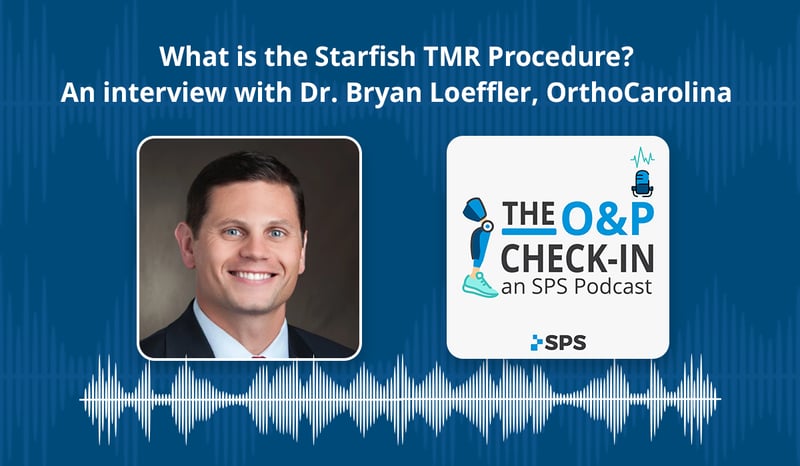
The pioneering surgical procedure, Targeted Muscle Reinnervation, made its debut in 2002. Since then, the procedure has adapted to treat a variety of upper and lower limb patients at the time of amputation or post amputation. One such adaptation is the Starfish Procedure developed by Dr. Bryan Loeffler and Dr. Glenn Gaston at OrthoCarolina.
We had the privilege of chatting about what the Starfish Procedure is and how it came to be with cofounder, Dr. Bryan Loeffler. The following includes an excerpt from our conversation. Click here to listen to the full conversation.
 The O&P Check-in: an SPS Podcast unpacks trends and stories from the tight-knit O&P community. From patient care, technology, best practices, and regulations, this podcast features topics that help you stay current. Join hosts Brendan Erickson and Jacki Green for new episodes bi-monthly.
The O&P Check-in: an SPS Podcast unpacks trends and stories from the tight-knit O&P community. From patient care, technology, best practices, and regulations, this podcast features topics that help you stay current. Join hosts Brendan Erickson and Jacki Green for new episodes bi-monthly.
Targeted muscle reinnervation (TMR) is a breakthrough surgical procedure developed for the management of nerve problems for amputees.
TMR can prevent or treat neuromas, and address issues with phantom limb pain, or pain within the residual limb. It can also help to control Myoelectric prosthetics. The procedure essentially takes a nerve that has been cut and no longer has a muscle to activate and reassigns that nerve to a new muscle.
Take for example, a person who has had an amputation at the forearm. When they think about closing their hand, their brain sends a signal that goes down the spinal cord and then down the nerves of the arm, but it never reaches the muscle it is targeting. We can take this live-wire nerve and reassign it to another muscle in the arm so it can serve as a biologic amplifier to make the muscle contract. The muscle contracting can be detected by a surface electrode to make a myoelectric hand close.
TMR allows us to harness signals traveling on these live-wire nerves to control devices in a way that is more intuitive for patients.
Could you explain how you and your colleague, Dr. Glenn Gaston, pioneered a new TMR procedure?
We began by taking the principles of TMR developed by Northwestern University. The original TMR procedure was developed for shoulder level disarticulation, which is taking the nerves and reassigning them to muscles in the chest to control a prosthetic device. Building off of their work, we applied the principles in different ways for people at the level of the arm and forearm. Refining the technique over the years based on results and patient feedback allowed us to release a unique contribution to the prosthetic field called the Starfish Procedure to help patients with partial hand amputation.
The Starfish Procedure was inspired by our patients who were having trouble generating enough of a muscle signal to cause the electric digits to close and open. We knew we could harness nerves deep within the palm of the hand and bring them directly underneath the skin to generate a stronger signal to control a prosthetic digit. If we could successfully reassign the nerves in the hand, each digit could be reassigned. The patient would only need to think about moving the index finger, the middle finger, etc., to control the corresponding prosthetic digit.
After much brainstorming and testing in phase one of the development process, we were able to identify a patient who made a great candidate for phase two to put all of our work to the test. They were fortunately not going to lose anything if it didn’t work, and the procedure added little time to the operation, so there wasn’t much in the way of additional risk incurred.
Within two weeks of the surgery, we could see little muscle bulges where we had performed the muscle transfer. We placed sensors over each of the muscles and could see electrical activity when the patient thought about moving their finger. We were absolutely thrilled with the results.
Since it’s inception, we have been able to partner with prosthetic clinics and perform the procedure on about 30 patients.
How did you come up with the name for the Starfish Procedure?
When we were in the lab, we wanted to think about how we could scale the procedure up once we figured out how to target each individual finger. Essentially, if the muscles are there and they still have nerve and blood supply, could we put them in the forearm if needed? We tested this on a donor’s wrist by saving all the muscles and reflecting it back, so each muscle went in different directions. It looked like a star. I said, “Oh, that looks like a starfish.” The name seemed to fit because the starfish is renowned for its unique ability to regenerate a limb.
To hear the full conversation and learn about what’s next for the procedure and which patients would make a suitable candidate for this surgery, click the following button:
Send a question to OrthoCarolina by emailing amputee@orthocarolina.com



